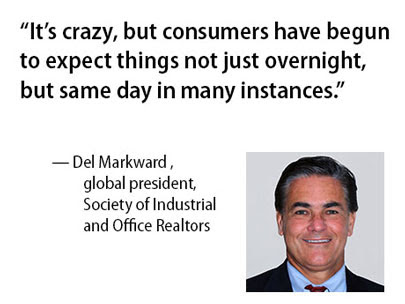Del Markward will be logging a lot of frequent flyer miles over the next year as he travels around the country and abroad to meet with several chapters of the Society of Industrial and Office Realtors (SIOR), an organization with more than 3,200 members in 685 cities and 36 countries.
In addition to serving as the 2018 global president of SIOR, Markward is founder of the Markward Group, a real estate consulting, advisory and brokerage firm based in Allentown, Pa.
Markward was officially inducted as president of the organization in October at the outset of the SIOR World Conference in Chicago. He most recently served as president-elect of SIOR and before that was vice president.
The commercial real estate community recognizes professionals who have earned the SIOR designation as among the most capable and experienced brokerage practitioners in any market, according to the organization.
On the heels of the SIOR World Conference, REBusinessOnline interviewed Markward about some of the dynamic changes taking place in the industrial real estate sector today, including the sharp rise in demand for space driven by e-commerce companies. What follows is an edited transcript of the Q&A.
REBusinessOnline: Supply chain logistics is an industry undergoing a dramatic shift due to changing customer expectations in an e-commerce world. What opportunities and challenges does that shift create for the industrial real estate sector as a whole, and brokers in particular?
Del Markward: In the past 15 years, we’ve seen a huge uptick in big boxes — ranging from 500,000 square feet to 1 million square feet — all around the country to accommodate e-commerce. In that time, we have approximately quintupled the amount of cubic feet in the market. We’ve watched these buildings go up to 1 million square feet and 36-foot clear heights. That gives us 36 million cubic feet of space in one property.
We’re losing Sears and Kmarts, which are 1.2 to 2 million cubic feet of space (they only store product on the floor for display purposes). Those buildings are going away and being replaced with 36 million-cubic-foot buildings for retail purchases via home delivery. The sheer scale of available capacity for retail and other products is an interesting dynamic.
While we’re seeing lots of those 1 million-square-foot buildings still go up, slowly in the big cities we are seeing a dynamic shift toward the last mile of delivery. They’re taking older, in-city warehouses and beginning to convert them — even if they’re multi-story — into storage depots to be able to deliver product the same day to customers.
And that’s just beginning to emerge. It’s going to happen in the big cities first, but it’s going to start infiltrating some of the other mid-size cities over a period of time. It’s crazy, but consumers have begun to expect things not just overnight, but same day in many instances, which is truly a different dynamic than what we’ve been used to.
REBO: According to Zac Rogers, assistant professor of operations and supply chain management at Colorado State University, there is more demand for industrial real estate today than there is supply. That’s largely because of the explosion in e-commerce business and the need for e-commerce firms to be near their customers. What effect has that had on rents and prices paid for industrial real estate?
Markward: We have watched land prices go up by as much as 30 percent in the last two to three years in many markets. Where there is land constraint, like in Los Angeles, you can’t find a piece of ground. If you do, the land values are rising up to $3 million to $5 million an acre just for an industrial lot, which is remarkable.
The rents have increased between 4 and 11 percent year-over-year in certain markets over the last three to five years. We have seen a significant rent increase partly because the cost to build has gone up. The days of constructing a building with land for $60 per foot are over, and it’s more like $100 to $150 per foot in many markets. Rents are running commensurate with those increases in costs to build.
REBO: How rapidly have land prices risen in California?
Markward: What happened in Los Angeles is that there is no more [available] ground inside the belts, if you will. That market has shifted a great deal to the Inland Empire, 60 miles to the east. That’s the nearest place where there is available land. A little bit to the north, up in Kern County, you see a little bit of activity, but most of it is in the Inland Empire. And the price of land in the Inland Empire has shifted significantly upward over the last five years for that same reason — pressures of population and the need to be near the population. The prices have followed.
It’s tough to answer the question with regard to L.A. proper. There’s almost no ground that’s ever made available. People are buying buildings there that would give them a land value of $3 million to $5 million. They’re tearing down existing product to put up a new warehouse, and the rents have to run with that new price structure.

